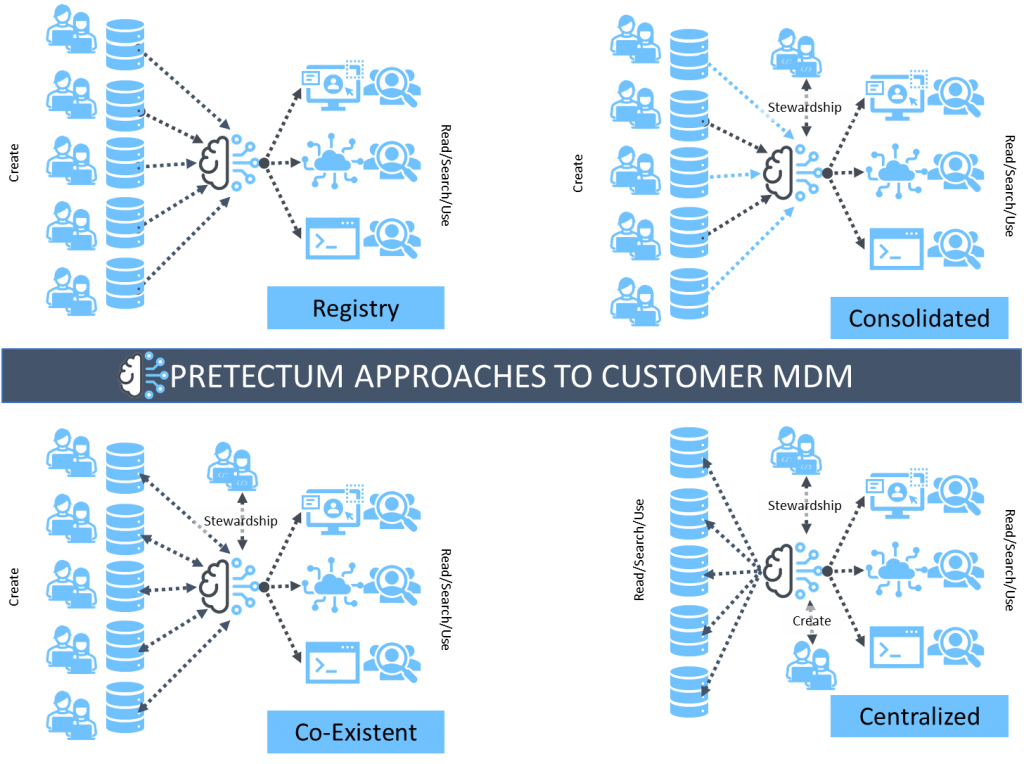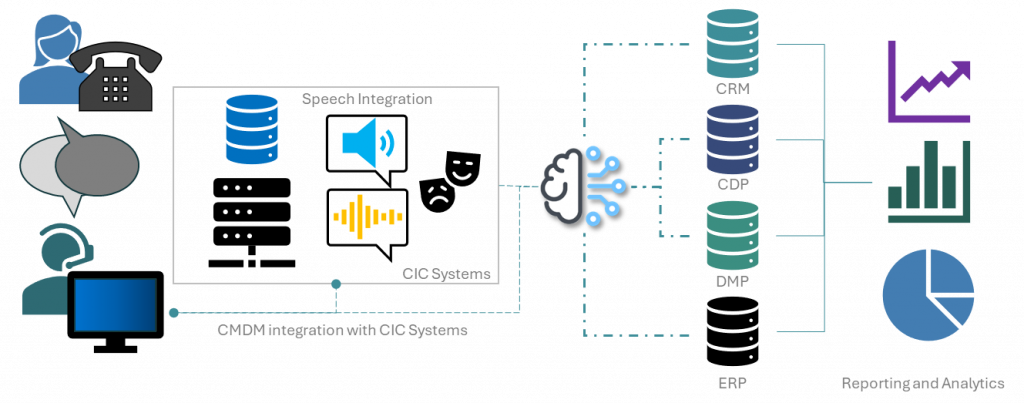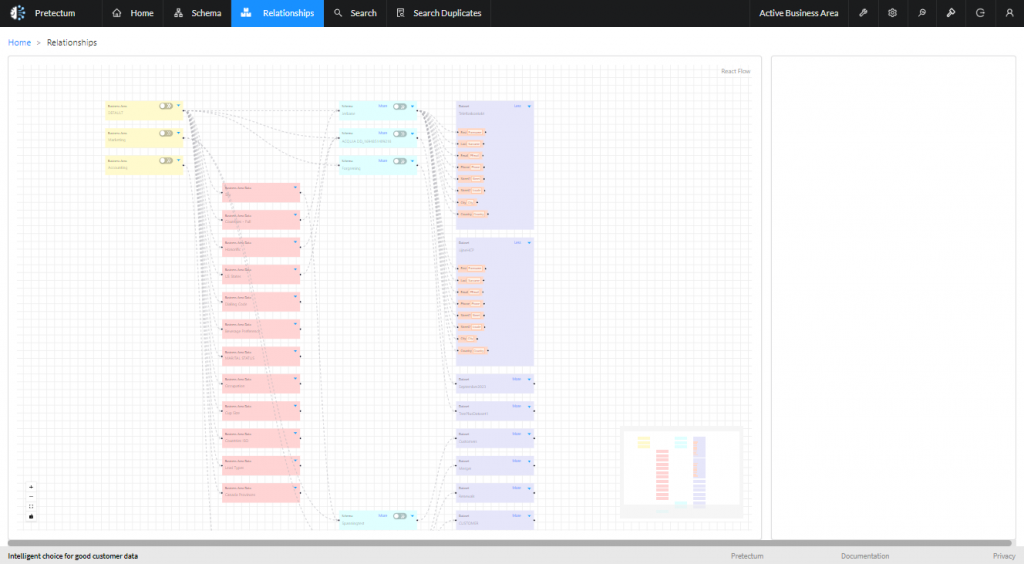Master Data Management (MDM) is a strategic approach that organizations utilize to manage their critical data assets effectively. This approach encompasses the processes, governance, and technologies necessary to create a unified view of essential data entities, such as customers, products, and suppliers.
By establishing a single source of truth, MDM helps organizations eliminate data silos, reduce redundancy, and enhance data quality across various systems and departments.
MDM and CMDM (Customer Master Data Management) are vital for ensuring the reliability of data sourced from various origins and in a variety of formats. Integrity, consistency and reliability are essential and CMDM supports essential initiatives such as Big Data insights projects, data analytics, artificial intelligence (AI) training, and digital transformation efforts in support of improved customer interaction, engagement and communications.
By establishing customer master file profiles that act as a common reference point, an organization can more effectively link all critical customer data, facilitating streamlined customer data sharing across the enterprise. An effective data integration strategy is crucial within this framework to ensure that CMDM can be implemented successfully.

Since the emergence of the internet for consumer-use, organizations have increasingly turned to their customer data to find opportunities to enhance operational efficiency and maintain a competitive edge. The quality of business intelligence (BI), analytics, and AI outcomes is directly tied to the quality of the underlying customer profile data.
In the absence of a unified single source of truth for customer profile data, organizations have to rely on the siloed and often inconsistent characteristics of a landscape of differing DMP, CDP, CRM and ERP systems that contain partial, inconsistent and potentially out-of-date customer data.
Golden Record Management
Pretectum’s customer MDM addresses several critical issues that can arise from historically poor customer data management practices. It helps remove duplicate records, integrates data from diverse sources, standardizes disparate data formats for more effective use, eliminates incorrect entries, and enables a single source of reference known as the “Golden Record.”
The processes involved in master data management are diverse and often interrelated. While the specifics may vary by organization, they typically include business rule administration, data aggregation, classification, collection, consolidation, distribution, enrichment, governance, mapping, matching, and normalization.
Effective CMDM creates a seamless flow of information between the data sources and the destination systems where that data is utilized.
Modern day metrics-driven organizations require coherent data management – a characteristic critical for competitiveness. Organizations that lag in customer MDM may find themselves at a disadvantage compared to competitors who prioritize more effective data management. One of the main benefits of implementing customer MDM includes enhancing control over customer data assets— thereby allowing an organization to know exactly where their data resides and how secure it is—this also drives improved accuracy of metrics tied closely to strategic objectives, and aligns with greater consistency across different data sources to avoid fluctuations in tracking underlying patterns.
Achieving data accuracy and consistency is vital as organizations become more dependent on accurate information for daily operations. When executed effectively, master data management can significantly improve customer experiences by enabling precise identification of customers across multiple touchpoints—different departments and channels.
This also enhances operational efficiencies by reducing friction often related to poor-quality data and streamlines customer interactions. Improving customer data management with customer MDM enables an organization to understand customer journeys better; customer master data management leads to gains in terms of deeper insights into product life cycles associated with customers and can assist with product strategy and operations management.

The application of customer MDM extends across diverse industries. In healthcare, providers can access patient records quickly for improved diagnostic accuracy and treatment efficiency.
Banking and financial services can reduce customer churn by delivering timely and personalized services based on more accurate customer information. Insurance companies benefit from improved claims processing efficiency while energy companies can better balance supply and demand. In retail and eCommerce, effective customer MDM helps reduce waste associated missteps associated with shipping, service and inventory management, retailers can better synchronize their operations across all channels for a more joined-up and cohesive customer experience.
Adoption challenges
Despite the many numerous advantages, implementing customer MDM may prove to be a challenge to evaluate and adopt. Challenges arise primarily due to poor data quality prevalent in many enterprises. Organizations often have multiple customer records stored in different formats and in different systems. Such situations can lead to treating existing customers as unknown prospects or facing issues like over exposure on credit risk due to duplicate profiles and inaccurate records. The common challenge of duplicate records, accompanied by erroneous or incomplete information leads to record inconsistencies across systems, and mislabeling of data. Pretectum addresses this duplicate search and matching accompanied by golden nominals and survivorship capabilities.

Several factors contribute to these poor data quality issues. A lack of data standards will often results in different account numbers associated with the same entity. Employees may take shortcuts when entering information—for instance, recording “J. Smith” instead of “John Smith.” Redundant data storage is often also an issue; the same customer might appear in multiple systems for sales, marketing, technical support, customer support, and finance. Without proper consolidation efforts, when unifying this data for upstream or downstream analysis, wastage is introduced. Varied field structures in different applications also necessitates the use of specific formats for entering similar types of information.
Recent trends have also influenced master data management practices significantly. The introduction of a growing number of privacy and consumer data handling regulations across the globe accompanied by heightened scrutiny regarding the use of Personally Identifiable Information (PII). Such regulations empower end-users with control over their personal information while prompting organizations to adopt robust customer MDM solutions to ensure compliance and reduce data loss risks.
An essential component of Pretectum’s approach to customer MDM is metadata management—the practice of managing “data about the actual data.” This aspect helps organizations ensure compliance with regulations while also enabling them to locate specific assets quickly and manage risks associated with poor-quality or unauthorized access to sensitive information. Effective metadata management is taxing, but increasingly critical for organizations that are regulated or serious about how they manage their data.

Before pursuing a customer MDM solution, it’s important for any organizations to understand basic customer master data management concepts thoroughly; lest their overall strategy lack essential capabilities. Some solution providers will offer reference architectures that describe these concepts while helping customers contextualize product offerings within their own organizational needs. These may be prescriptive or simply guide. Pretectum’s CMDM provides guard rails for implementation but remains focused on delivering capabilities that are functionally rich and aligned with the most common business patterns used for customer master data management dependent on the maturity of the organization.
As businesses continue evolving amidst growing data volumes and varieties of data, mastering customer MDM remains essential. The complexity associated with expanding capabilities necessitates streamlined solutions like Pretectum CMDM, solutions that simplify management tasks while enhancing competitiveness whether you have a formal data management organization or are focused simply on business-unit-based operations excellence.
When executed properly, customer master data management empowers an organization to integrate disparate datasets into cohesive hubs that facilitate syndication and replication across various destinations while providing unified views essential for informed decision-making processes. Such integration allows an organization not only to maintain control over critical customer data assets but also ensures that they high-quality master data is used for operational excellence and strategic growth going forward.
Businesses must transition from traditional reporting in support of self-service analytics and adopt AI-powered systems reliant on high-quality training datasets for machine learning purposes, the importance of effective customer master data management cannot be overstated in this context. Organizations must also prioritize customer MDM to enhance operational capabilities, reduce risk, reduce cost and increase efficiency, all while navigating the increasingly complex regulatory landscape that surrounds personal data and personal information usage. In so doing, they position themselves not just for alignment with compliance obligations, but also set themselves up for sustained success in an increasingly competitive market landscape where accurate and reliable customer information is essential.
Learn more about how Pretectum can assist.


